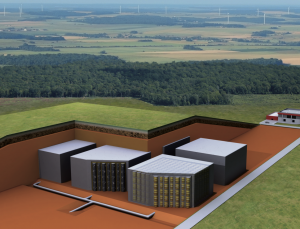Reduction methods for thermo-hydro-mechanical systems
The problem of radioactive waste
The disposal and storage of high-level radioactive waste materials in geological means requires a careful assessment of the long-term effects on neighboring areas.
Radioactive material is placed in an array of horizontal boreholes (alveoli) deep underground: due to the large temperature of the alveoli, a thermal flux is generated; the thermal flux then drives the mechanical and hydraulic response of the medium over the course of more than 100 years.
The system behavior is well-described by time-dependent large-scales thermo-hydro-mechanical (THM) systems of PDEs which take into account the thermal, hydraulic and mechanical response of the geological medium.
Model reduction for a class of models in nonlinear mechanics
We state the primary variables U and the internal variables W in suitable Hilbert spaces in Ω, and we introduce the parametrized problem of interest: given the parameter μ ∈ P, we aim at solving
with suitable initial and boundary conditions. Here, the first row in the system is associated with equilibrium equations (equilibrium of mechanical forces, mass conservation of water and energy balance), while the second is a set of ordinary differential equations (ODEs) that is associated with constitutive laws linking internal variables to the primary ones.
We developed projection-based monolithic model order reduction (MOR) procedure for that class of problems in nonlinear mechanics with internal variables. In particular, we developed an adaptive sampling strategy based on the POD-Greedy method, and we developed an element-wise empirical quadrature hyper-reduction procedure to reduce assembling costs.
Numerical results
We first present numerical results in the in-sample case.
Some of the physical variables of interest are shown for a fixed configuration of parameters.
Hyper-reduction
We show the performance of the Galerkin ROM with and without hyper-reduction. We distinguish between the high-fidelity quadrature rule, abbreviated as hfq, and the empirical quadrature rule for several empirical quadrature tolerances.
We observe that the empirical quadrature procedure is able to significantly reduce the size of the mesh used for online calculations without compromising accuracy.
Prediction tests
Here, we assess out-of-sample performance of the developed ROM. More precisely, we show the behaviour of the maximum relative error over a given test set of out-of-sample parameters.

Out-of-sample performance of the ROM parametric problem obtained using a POD-Greedy algorithm. Comparison with strong POD-Greedy algorithm.
We observe that the generated ROM is accurate: in particular, the Greedy procedure based on time-averaged error indicator is comparable in terms of performance with the corresponding strong POD-Greedy algorithm.








